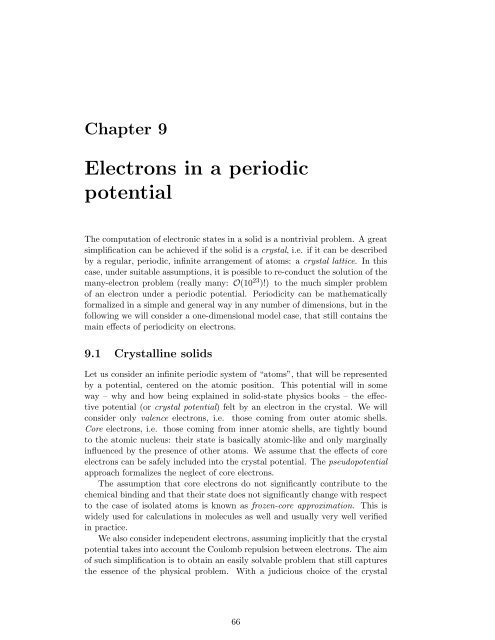Numerical Methods in Quantum Mechanics - Dipartimento di Fisica
Numerical Methods in Quantum Mechanics - Dipartimento di Fisica
Numerical Methods in Quantum Mechanics - Dipartimento di Fisica
You also want an ePaper? Increase the reach of your titles
YUMPU automatically turns print PDFs into web optimized ePapers that Google loves.
Chapter 9<br />
Electrons <strong>in</strong> a perio<strong>di</strong>c<br />
potential<br />
The computation of electronic states <strong>in</strong> a solid is a nontrivial problem. A great<br />
simplification can be achieved if the solid is a crystal, i.e. if it can be described<br />
by a regular, perio<strong>di</strong>c, <strong>in</strong>f<strong>in</strong>ite arrangement of atoms: a crystal lattice. In this<br />
case, under suitable assumptions, it is possible to re-conduct the solution of the<br />
many-electron problem (really many: O(10 23 )!) to the much simpler problem<br />
of an electron under a perio<strong>di</strong>c potential. Perio<strong>di</strong>city can be mathematically<br />
formalized <strong>in</strong> a simple and general way <strong>in</strong> any number of <strong>di</strong>mensions, but <strong>in</strong> the<br />
follow<strong>in</strong>g we will consider a one-<strong>di</strong>mensional model case, that still conta<strong>in</strong>s the<br />
ma<strong>in</strong> effects of perio<strong>di</strong>city on electrons.<br />
9.1 Crystall<strong>in</strong>e solids<br />
Let us consider an <strong>in</strong>f<strong>in</strong>ite perio<strong>di</strong>c system of “atoms”, that will be represented<br />
by a potential, centered on the atomic position. This potential will <strong>in</strong> some<br />
way – why and how be<strong>in</strong>g expla<strong>in</strong>ed <strong>in</strong> solid-state physics books – the effective<br />
potential (or crystal potential) felt by an electron <strong>in</strong> the crystal. We will<br />
consider only valence electrons, i.e. those com<strong>in</strong>g from outer atomic shells.<br />
Core electrons, i.e. those com<strong>in</strong>g from <strong>in</strong>ner atomic shells, are tightly bound<br />
to the atomic nucleus: their state is basically atomic-like and only marg<strong>in</strong>ally<br />
<strong>in</strong>fluenced by the presence of other atoms. We assume that the effects of core<br />
electrons can be safely <strong>in</strong>cluded <strong>in</strong>to the crystal potential. The pseudopotential<br />
approach formalizes the neglect of core electrons.<br />
The assumption that core electrons do not significantly contribute to the<br />
chemical b<strong>in</strong>d<strong>in</strong>g and that their state does not significantly change with respect<br />
to the case of isolated atoms is known as frozen-core approximation. This is<br />
widely used for calculations <strong>in</strong> molecules as well and usually very well verified<br />
<strong>in</strong> practice.<br />
We also consider <strong>in</strong>dependent electrons, assum<strong>in</strong>g implicitly that the crystal<br />
potential takes <strong>in</strong>to account the Coulomb repulsion between electrons. The aim<br />
of such simplification is to obta<strong>in</strong> an easily solvable problem that still captures<br />
the essence of the physical problem. With a ju<strong>di</strong>cious choice of the crystal<br />
66
















